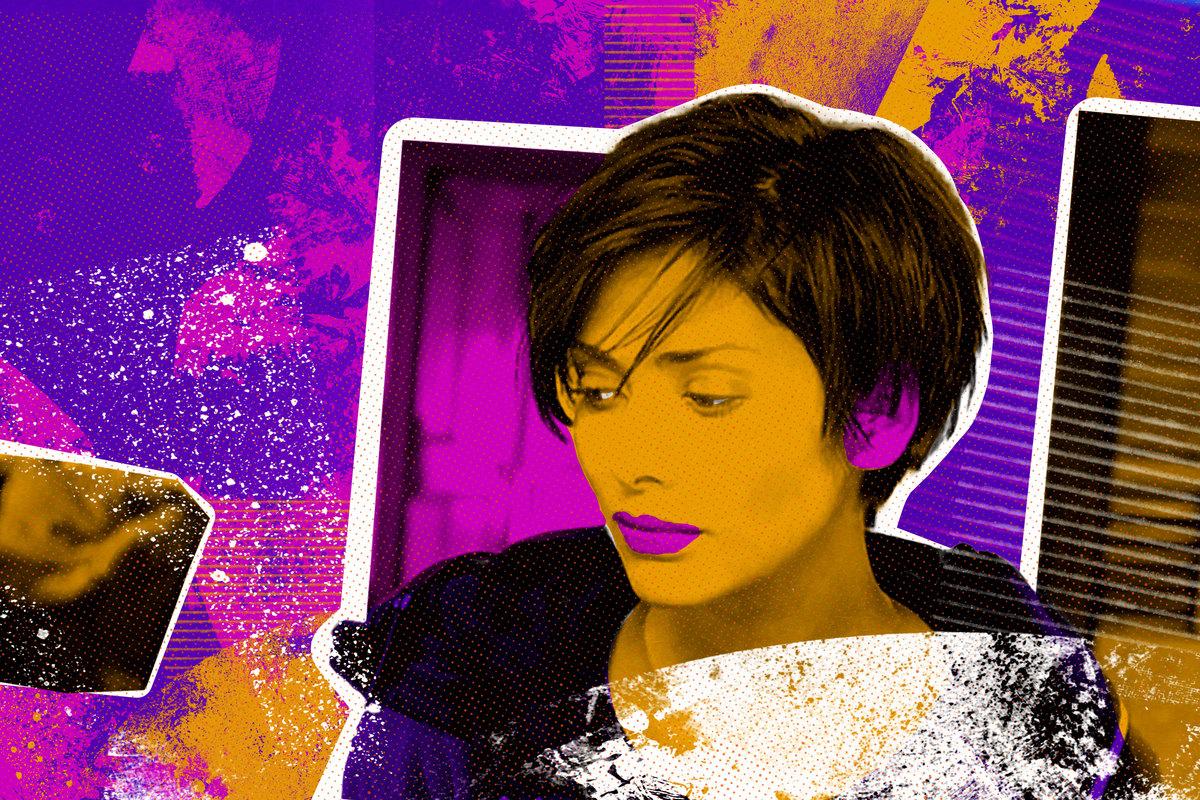
Grunge. Wu-Tang Clan. Radiohead. “Wonderwall.” The music of the ’90s was as exciting as it was diverse. But what does it say about the era—and why does it still matter? 60 Songs That Explain the ’90s is back for 30 more episodes to try to answer those questions. Join Ringer music writer and ’90s survivor Rob Harvilla as he treks through the soundtrack of his youth, one song (and embarrassing anecdote) at a time. Follow and listen for free on Spotify. In Episode 89 of 60 Songs That Explain the ’90s—yep, you read that right—we’re covering Natalie Imbruglia’s cover of “Torn” (and talking with the legendary Sophie B. Hawkins about it). Below is an excerpt of this episode’s transcript.
So. 1995. The Los Angeles alternative rock band Ednaswap releases their first album, self-titled. I am pleased to report that it rules.
I love the high note there so much. That song’s called “Pale.” Anne Preven is your lead singer. There is a marvelous grit, a palpable snarl to Anne’s voice. It’s a fantastic mid-’90s alt-rock-star voice. Dim, dimmer, dimmest. She has a diaphanous hostility. Every chorus this woman sings is like a chain saw through a birthday cake.
That song is called “Minor Crap.” That’s what it’s called. I double-checked that several times as well. This is a snarling underground rock band; this is not a band necessarily chasing pop stardom, however you might define the term pop stardom in 1995. I could throw out a bunch of names of female-fronted and distortion-minded mid-’90s rock bands, if you want to orient yourself that way: Eve’s Plum, Veruca Salt, Garbage, Hole bears mentioning, Alanis Morissette certainly bears mentioning. But that’s reductive and a little embarrassing of me to go all women in rock on you. You know who I hear sometimes, quite clearly and gloriously, on the first Ednaswap record in particular? Jane’s Addiction.
This song is called “More.” It is, to my mind, Ednaswap’s “Mountain Song.” I do believe she’s wide awake, and the perfect sky is torn.
This first Ednaswap record is not on streaming services. As such, this is a YouTube or Discogs.com situation, if you’d like to hear it now, and I do emphatically recommend that. It feels a little reductive in its own way for me to go overboard here and say this band should’ve been famous. Let’s not get carried away. That’s not up to me or you or, for that matter, them, nor is getting famous the goal or, for that matter, a reliable indicator of quality, etc., etc. Listen. I’m walking around all day—and this was true long before this show ever existed—I’m walking around with like 5,000 random-ass ’90s-era band names in my head, bands I heard of but never got around to listening to, right? You want one? Here: Gorky’s Zygotic Mynci. You ever see that band name? I’ve seen that band name. I gotta get up on those guys. But so whether or not Ednaswap is one of those names for me or one of those names for you, let’s just say that my takeaway here is that it’s worth actually investigating a few of those random-ass names from time to time.
OK. We got a little carried away there, sorry. Let’s get down to business—13 songs on the first Ednaswap record. This is track 12.
“He showed me what it was to cry.” The extra little zhuzh on the word dignified there, that’s a cold cup of coffee. OK. Here we have an Ednaswap song called “Torn.” Two people in this band, Anne and Scott, wrote this song with a guy who used to be in the Cure. It’s their song. A Danish lady already had a hit with this song, but under a different title, different lyrics, on another continent. Circa 1995, “Torn” is a new, unsullied original song for all you know. And what I’d love to do—and genuinely, I’d pay like $20 to do this—I’d love for Will Smith or Tommy Lee Jones to zap me with the Men in Black memory eraser deal for just an hour so I could listen to the Ednaswap record from beginning to end just to see if I would immediately identify “Torn,” track 12, as a colossal blockbuster pop song waiting to happen. I’d like to think I would, even if in this hypothetical I’d never heard “Torn” before and had no idea anybody else would ever sing “Torn.” I’d like to think I’d be shrewd enough to hear the massive potential. There is a certain aura present here. This is a bigger, fluffier cake and a sharper chain saw. Let’s jump to the second pre-chorus, actually, because this always struck me as a beautiful line as well.
I don’t care
I have no luck
I don’t miss it all that much
There’s just so many things
That I can’t touch, I’m torn
“I don’t care / I have no luck / I don’t miss it all that much.” I always really dug that. “Torn” is not some huge anomaly on this Ednaswap record. It’s grimy; it’s noisy; we’ve got no acoustic guitar softening it up. In fact, back up: Here’s what we got going on 10 seconds into the original “Torn.”
It just popped into my head that Pink—the pop star Pink, “Get the Party Started” and “So What” and so forth—she dangles from the ceiling on, like, scarves a lot. Pink really ought to cover this song. She’s a pure pop star but with an ’80s and ’90s rock-star voice and haircut and temperament, let’s say. Pink is precisely the midpoint between where “Torn” is right this second and where “Torn” is about to be. But the song, the Ednaswap song, the original song, it’s all undeniably there. The chorus is undeniably there. It would be rude of me to not play the Ednaswap chorus—and not the good, rock ’n’ roll, that’s-what-Pink-would-do sort of rude.
It’s there. If Tommy Lee Jones or Will Smith had zapped you with the Men in Black memory eraser, would you identify this, in slightly different form, as the chorus to the most-played song on the radio in Australia for the past 30 years? I’d like to think you would. I have faith in you. The backing vocals, right at the end, the ahhhhh that pops up here. If nothing else, I’d like to think this would’ve tipped you off to how big this song could get.
And then the song just sort of drifts away for 45 seconds. If we’re being critical, if we’re getting all forensic, if we’re aggressively charting the differences between the underground rock version and the blockbuster pop version of “Torn,” this version ends the way track 12 on a 1995 rock album ends, not the way track one on a millions-of-copies-selling 1997 pop album ends.
But even that giant, swooping guitar note—though not yet the slide guitar note, I suppose—even that is most of the way there, here, already. We’re almost to Natalie, but we’re not quite to Natalie. Before we get to Natalie, we gotta make one more quick stop in … Norway!
“He showed me what it was to cry.” Here we have Norwegian pop star Trine Rein. Norwegian American. She was born in San Francisco. From her second album, Beneath My Skin, from 1996—also her second straight no. 1 album in Norway—here we have Trine Rein with, well, it’s “Torn.” It’s arguably more “Torn” than the original “Torn,” if that makes any sense. How about that? Beat that with a stick.
I have to say that, much like our Danish friend Lis Sorensen, Trine Rein also appears to like horses, or, in any event, horses really like and trust her. At this exact moment in the video for her version of “Torn,” Trine’s holding the reins to two horses standing behind her, one in each hand, and she lifts her arms, and both horses rear up majestically on their hind legs as the chorus hits. I’m tempted to say that’s the most impressive stunt I’ve ever seen in a music video, full stop. I don’t think I could do that, and I don’t think even Prince, necessarily, could’ve done that. On account of the tremendously impressive horse action in this video, I will look more charitably upon the wah-wah guitar situation taking place here, nor will I give Trine too much sass for literally wearing a veil and waving her hands over a crystal ball as she sings about the fortune teller.
Pretty good, right? Pretty familiar, right? Let’s see how Trine handles the end of the song. I sure do hope a horse does something cool at the end of the song as well.
Yes. More horse action. Right when the slide guitar hits, the camera zooms in on a horse majestically rearing up on its hind legs again, like zooms in on the horse’s face, and the horse gives the camera a look, like, Oh, fuck yes. Amazing. Just amazing. I know very little about Norway, but this is the most gloriously Norwegian work of art I’ve ever laid eyes on. That’s the slide guitar riff. That’s quite familiar. This is the “Torn”-est “Torn” yet, I think it’s safe to say. Who produced Trine Rein’s version of “Torn” anyway? Phil Thornalley. That’s who. Mr. Cowriter of the Song. Mr. I Used to Be in the Cure. Mr. “Lovecats.” Mr. Cool. Phil has taken matters into his own hands. Phil appears to be of the opinion that “Torn” has not yet reached its full potential as a pop song, and Phil remains of that opinion, even after Trine Rein’s version, even though Trine’s version is excellent. So Phil tries again.
I’m very sorry. I don’t know how that got in there. That’s the third level of PaRappa the Rapper, which I don’t believe anybody in my band ever got past. We didn’t have much rhythm. As of course you remember, that is Prince Fleaswallow, the Jamaican frog, who is toasting at a flea market as he sells skunks. I do marvel sometimes. It’s quite endearing, isn’t it, the image of a hapless American rock band playing a weird Japanese video game in which a dog learns to rap thanks to the interventions of a Rastafarian frog and a jovial moose named after an Italian dictator. Lifes Rich Pageant, you know? So cosmopolitan. Never mind. Forget it. I’m sorry.
“He showed me what it was to cry.” Natalie Imbruglia was born in Sydney, Australia. She grew up singing Carpenters and Whitney Houston and Beatles and Michael Jackson songs into a hairbrush. She got big into dance. She wanted to be a star; that weirded out her parents, but they got over it. She studied performance arts at the McDonald College boarding school, and at 16, she left school to play the role of Beth Brennan, the kindhearted if perhaps too trusting construction industry builder’s apprentice in the Australian soap opera Neighbours. Neighbours with a U. She was on the show from 1992 to ’94. Here is Beth sassing her fiancé, Brad, while trying to get him to lock down his best man at their wedding. Beth, in fact, left Brad at the altar after discovering his infidelity, but then they patched it up and got married for real. It was a good experience for her.
Natalie left Neighbours in 1994 to pursue a music career in London. That arc, from Australian soap opera renown to international pop stardom, is officially known as the Kylie Minogue. Hallowed company. Natalie got a record deal after what a 2021 Irish Times profile describes as “a period of partying and aimless drifting.” I can relate. Not to the partying, the drifting. Natalie is a voracious songwriter; her debut album, released in 1997 and called Left of the Middle, has 12 songs, and she cowrote 10 of ’em. As it happens, this was one of the other two.
Who we got here? Oh, look, it’s Mr. “Lovecats” himself, Phil Thornalley, on bass and some guitars and production. We got David Munday on lead guitar. We got Chuck Sabo on drums. We got Katrina, from Katrina and the Waves, Ms. “Walking on Sunshine” herself, on backing vocals. We got the English electronic-music duo Zero 7 on the drum loop. We got Nigel Godrich on the mix, Nigel best known in 1997 for producing a little album called OK Computer, by a little band called Radiohead. We got quite a crew here, and for a solid half-decade, we have dragged this poor song back and forth across the globe in a prolonged attempt to realize its true potential, but finally, we have arrived at the “Torn” to rule them all, and we have found the singer who will sing the “Torn” to rule them all—and my theory, at this hour, is that Natalie Imbruglia takes command of this song on the line “This is how I feel.”
It is an unnecessary line on paper, “This is how I feel.” Whoever you are, however you’re feeling, whatever song you’re singing, it is redundant to sing “This is how I feel” as you sing about how you feel. No? And yet the line “This is how I feel” is necessary here as Natalie delivers it, with the emphasis and the resignation Natalie brings to it. And it could be that an Australian soap opera star has the precise, intangible skill set required to infuse the precise amount of understated melodrama into “This is how I feel,” turning the line from unnecessary to very necessary. It could be. That’s my theory right now.
To hear the full episode click here, and be sure to follow on Spotify and check back every Wednesday for new episodes on the most important songs of the decade. This excerpt has been lightly edited for clarity and length.

